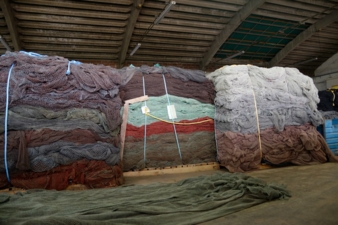29/06/2016 – Econyl — auf Deutsch lesen
Combatting plastic waste in the sea
The Econyl Project has been committed to the eradication of plastic waste. Econyl can produce yarn for more than 10,000 square metres of fitted carpet.
In 2010, the USA and the EU produced almost 15 million tonnes of textile waste. What for some is regarded as waste is seen by others as a valuable source of raw materials. After all, this textile waste contained around a million tonnes of usable nylon. The yarn generated from this nylon displays the same properties as nylon fibres produced from scratch; it is of the same quality and is suitable for all kinds of further processing.
The Econyl Regeneration System
The Econyl Regeneration System includes several processing steps to extract nylon material from waste created during textile production or from discontinued ranges. Irrespective of whether these materials are retrieved from the sea or directly from the producer, the company’s recovery programme enables them to be collected globally and made available for further processing. During the production of the yarns, more waste is used than created, giving rise to an extremely positive life cycle assessment.
Positive LCA
In 2015, the Econyl Regeneration System helped to reduce CO2 emissions by more than 100,000 tonnes, saving more than 2 million gigajoules of energy. This corresponds to the CO2 emissions of a car circumnavigating the equator 15,000 times or the energy requirements of a city such as Rome over a ten-day period. From every tonne of disused fishing nets, Econyl can produce yarn for more than 10,000 square metres of fitted carpet, whilst making an important contribution to reducing the huge amount of plastic waste in our seas.
The idea
Giulio Bonazzi, Chairman and CEO of Aquafil, who has developed the Econyl Project together with his team, has been committed to the eradication of plastic waste in our seas for many years now. In our print edition 7/8 2016 from / since 4 July, you read his complete story.




